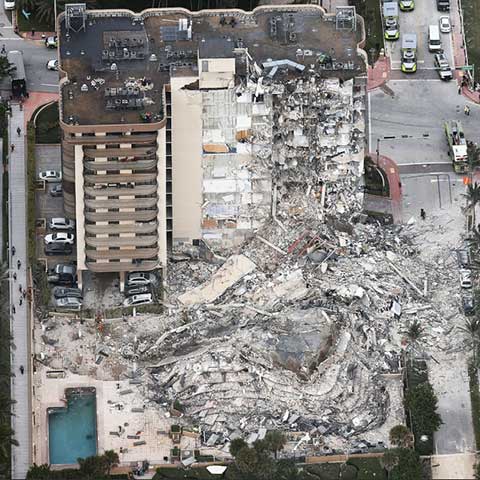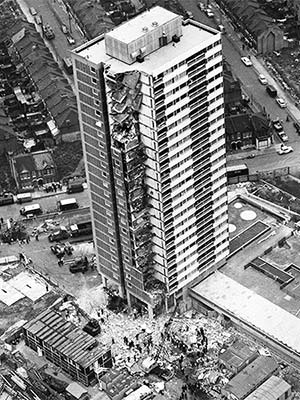Why Do Buildings Fall Down
Buildings shouldn't fall down but sometimes the do. Most modern buildings are built using reinforced concrete that combines concrete with steel reinforcing bars (rebar), to provide an amazingly strong and durable building material gives high structural strength to our buildings.
Here we look at how good design, mixture and pouring of the concrete for columns, beams and floors is vital to construct strong buildings. Taking care to protect reinforced concrete from damage such as corrosion of the steel is also vital to keep buildings safe and give them a long lifespan.
We look at factors that can lead to failure and even collapse of buildings such as unexpected natural disasters, poor design, poor construction, lack of inspection, inadequate repairs and poor maintenance.

12 Floor Champlain Towers Collapses in Florida
At around 1:30 in the morning on Thursday June 24th 2021, in the small town of Surfside near Miami in Florida, USA, a large section of a 12 storey beachside residential building collapsed. Over 150 people are missing.
The building was completed in 1981 and had not been reconditioned since.
The cause of the collapse is not yet known however an inspection report from 8th October 2018 suggests the probable cause. The inspection found "abundant" cracking and spalling of the columns, beams and walls in the garage under the tower that fell.
Note that the Columns are holding the whole building up and any major failure of the columns will bring the whole building down.
The report also noted that "many of the previous garage concrete repairs" were "failing."
The report also said the waterproofing below the pool deck was failing and causing "major structural damage. "We also read that “water underneath the surfside building was a long-standing concern of residents before the collapse.”
The structural engineering company that inspected building in 2018 says it “detailed significant cracks and breaks in the concrete” and gave estimates for “extensive and necessary repairs”
Probably the greatest risk for reinforced concrete is the penetration of salt laden air or water into the concrete which causes the reinforcing bar in the concrete to corrode.
The risk of corrosion is considerably increased if the water is salt water (such as sea water) or if it has chlorine in it (as you would find in a swimming pool).
Underground carparks next to beaches may suffer flooding by sea water as I found out many years ago when leak sealing and underground carpark in Caloundra, Australia.
Clearly there were warnings before the building suffered a catastrophic failure.
Sadly a resident (who is now missing) reported being woken the night before the collapse by a creaking sound…….
Reinforced Concrete
In buildings, reinforced concrete is used extensively for columns, beams, floors, roofs and staircases. It is important that the steel bars are placed correctly in the concrete, far enough apart to prevent bending of columns and beams but with enough concrete cover to protect the steel from rusting.
Air and Water Penetration is a Major Vulnerability for Reinforced Concrete.
The condition of reinforced concrete can deteriorate over time due to the fact that the air in the surrounding atmosphere can penetrate up to 6cms into concrete. If there is not enough concrete covering the steel to protect it from the air, the steel may well corrode (rust). Any cracks in concrete can also allow air in that will corrode the steel.
As steel rusts it expands and this expansion can crack the concrete open. It can also lead to spalling where small pieces break out of the surface revealing the reinforcing bar beneath. The strength giving bond between the steel and concrete is lost and the structural strength of the building is greatly reduced.
If columns are damaged in this way the exposed steel bar is no longer contained leaving it free to buckle outwards, this can lead to very sudden, dramatic failure of a building.
It is generally understood that, to protect the steel, it must have a minimum of 7cms (about 3 inches) thick coverage of dense concrete.
Reinforced Concrete is more vulnerable close to the Sea
This type of damage is particularly prevalent close to the sea where, due to sea breezes, the air has a high salt content. This effect can be felt as far inland as 50 miles (80 kilometres) from the sea.
How Do We Identify Reinforcement Corrosion
To identify corrosion of reinforcing steel we look for brown rust stains around a building, particularly around cracks in the concrete. This indicates probably corrosion of the reinforcing steel and a serious threat to the integrity of the building.
So What Could Cause Such a Catastrophic Failure
Let us look at the question of how and why a building like this could collapse?
Across the world there are hundreds of thousands of high rise buildings, most collapse as a result of natural catastrophes, poor design, poor construction, building modification or building misuse.
Natural and Man Made Catastrophes
The first thing to consider is whether the cause is some natural catastrophic event such as an earthquake, tsunami or serious weather event.
Next we consider whether there was subsidence under the building foundations. This could be caused by a landslide, an underground aquifer washing out the ground underneath the foundations, damage caused by rising sea levels or the tidal surges that often occur in hurricane or cyclone prone areas.
If a building is close to the beach (particularly a sand spit) it may be built on sand and it is common that as the tide comes and goes the sand is flooded and drained with each passing tide. This could cause movement of the sand and subsidence.
Human activities such as tunnelling, mining or excavations can cause subsidence which in turn can cause buildings to collapse.
Ronan Point Tower London

Gas explosions can have surprising force and in the past have brought large buildings down. In May 1968 a quarter of the 22 floor Ronan Point tower block in London collapsed due to a gas explosion on the 18th floor. The building was of prefabricated construction and the explosion blew out load bearing walls. The use of gas in high rise buildings is probably not a good idea.
Building “Renovation” or Modification
In some parts of the world where building standards are not clearly defined and enforced buildings may be modified in dangerous ways which may result in collapse.
In an earthquake in Sumatra, Indonesia caused a 6 floor hotel to collapse. Originally built with only 2 floors the hotel had been modified with 4 additional floors being added seriously overloading the foundations and lower structure.
Building renovations or modifications that involve removing structural walls or columns can often lead to Building collapse. It is essential that structural engineering expertise is sought for remodelling projects even on small buildings.
Adding a swimming pool or growing trees on a high rise building can dramatically increase the weight the structure is supporting, weight that the building probably wasn’t designed to carry.
Carrying out repairs to a building such as adding an extra layer of concrete to a roof may also add extra weight.
Building Structure Design
Let us look at some engineering considerations.
The strength of a building is dependent on its structural design and the standard of construction.
Good Foundations are Critical
When designing a building structural engineers study the geology of the area, they carry out soil tests to find out how strong the ground is and, using the results, they design the building foundations capable of withstanding whatever forces are expected.
Substantial concrete or steel piles (vertical supporting posts) are often driven or cast into the ground to provide solid foundation “piers” for multistorey buildings. It is important that such foundations reach far enough down to get into stable ground.
Foundations need to be equally loaded. If subsidence (sinking) occurs to some of the foundation piers but not others, this imbalance can result in flexing or twisting in the structure above causing cracks which in turn can lead to damage and failure.
The Building Structure
A reinforced concrete framework of columns, beams, floors, liftwells and staircases is usually constructed on the foundation piers to provide a strong “skeleton” for the building. Relatively lightweight walls, roof, ceilings, windows and doors will then added.
The dimensions of these columns and beams are very carefully calculated to both carry the weight of the building and withstand the stresses and strains the building is likely to experience through its life.
Shock loads
It should be noted that multistorey buildings are not designed to take heavy shock loads. As was clearly demonstrated when the twin towers fell in New York City in 2001, if a floor collapses the shock loading will often take the floors both above and below with it, the building “pancakes” piling and shattering the floors one on top of the other.
Standard of Construction
While the building designers and structural engineers may take ultimate care in producing a safe, structurally sound design of equal importance is the standard of construction in determining the strength of a building.
Trying to work within tight budgets and time schedules (the result of competitive tendering rather than realistic “actual cost” tendering) construction companies may be tempted to cut corners wherever they can. On large scale projects large amounts of money can be saved by shaving only small amounts off the costs of the materials or labour of often repeated individual tasks.
Added to this is the fact that construction workers may lack the technical knowledge or experience to fully understand the consequences of what they do.
Take, for example, the basic skills of placing concrete. Adding water makes concrete much easier to work with but considerably reduces the strength of the final concrete. Vibrating the concrete to increase its density can be frustrating and may be omitted. For these reasons constant testing of concrete strength is carried out as a construction project proceeds.
The Strength of Reinforced Concrete
Reinforced concrete is used extensively for construction across the world. It is a very strong material but its strength is dependant on correct design and construction. It has two components, concrete and steel bars (reinforcing bar or rebar).
Concrete is very resistant to compression but can crack with sideways or stretching forces. The steel has very high tension (stretching) and shear strength but it can bend easily.
By encasing steel bars in a covering of dense concrete we combine the qualities of the two and we have an amazingly strong building material.
It is very important that both the concrete and steel are of the correct specifications. It is also very important that the concrete is mixed correctly and that it is vibrated as it is poured to remove air cavities and bubbles leaving the concrete very dense and hard.
Summary - Reasons Why Buildings Fall Down
Using practical experience and common sense, there is little reason why buildings should fall down. As we have said, many do and the reasons why they fall down can be summarised as follows:
- Unforeseen circumstance such as earthquakes, floods or eruptions.
- Building in the wrong place such as on a flood plain or on unstable ground.
- Inadequate design.
- Poor construction.
- Cutting corners to minimise construction and/or maintenance costs.
- Inadequate inspection and maintenance regimes.
- Lack of corrective action if faults are found.
- Building modifications that weaken the structure.
- Construction, nearby excavation or maintenance work that causes vibrations or tremors in the building.
- Compromising of structural strength to achieve beautiful designs.
Phil Wilson
Copyright © Phil Wilson June 2021
This article, or any part of it, cannot be copied or reproduced without permission from the copyright owner.
